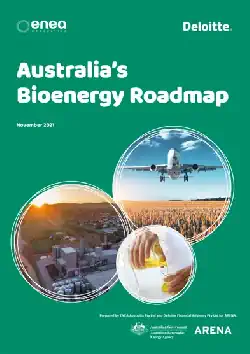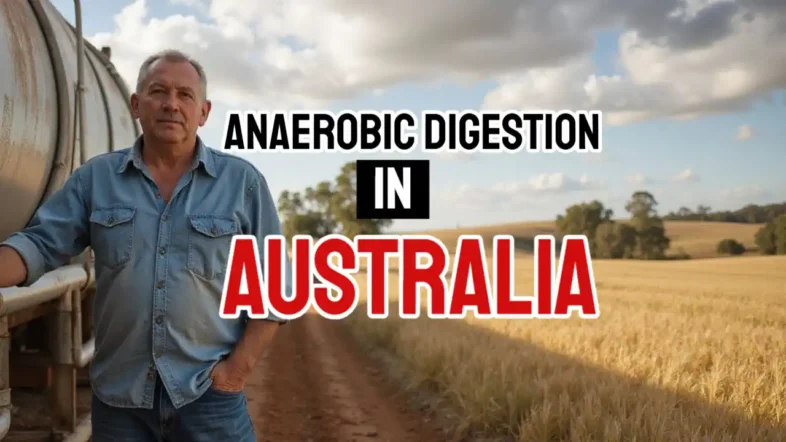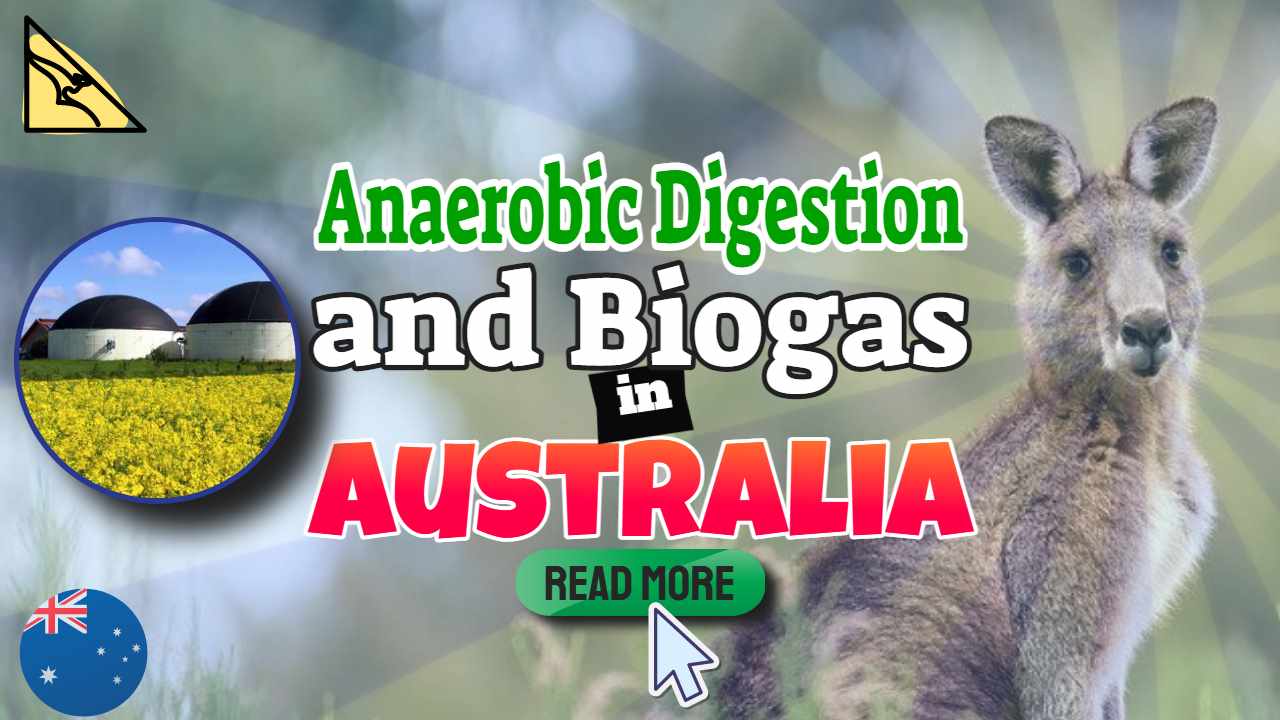Have you ever wondered what happens to all the food scraps, garden waste, and leftover organics we toss every day? In Australia, much of it still ends up in landfills, producing harmful greenhouse gases like methane.
With climate change pressing harder than ever and fossil fuels on the decline, finding cleaner energy sources is no longer optional but essential.
Enter anaerobic digestion. This clever process turns organic waste into biogas and nutrient-rich fertiliser while cutting down emissions. It's gaining traction across Australia as a way to manage waste more sustainably and produce clean energy at the same time.
In this blog post, you'll discover how anaerobic digestion works here, its benefits for industries and homes alike, and why it's vital for Australia's future.
Curious? Keep reading!
Key Takeaways
- Anaerobic digestion turns 20 million tonnes of organic waste into biogas and natural fertiliser, reducing methane emissions and landfill reliance.
- As of 2016, Australia had 242 anaerobic digesters located at farms, wastewater plants, and industrial sites like Yarra Valley Water’s Aurora facility.
- Biomethane projects, such as the Malabar Biomethane Injection Plant backed by ARENA, inject renewable gas into networks powering Sydney homes.
- Home biogas systems save households up to $3,800 annually by recycling food waste into cooking gas while supporting off-grid living.
- Barriers include outdated regulations limiting biomethane injection and slow approval for new AD projects despite high growth potential in bioenergy.
Development of Anaerobic Digestion in Australia

Anaerobic digestion gained momentum in Australia after years of slow progress. Growing concerns about waste disposal and energy security now fuel its expansion.
Why did anaerobic digestion have a slow start and what is driving recent growth?
Government policies initially slowed anaerobic digestion in Australia. Limited incentives and scaled-back programmes like the Renewable Energy Target after 2015 hindered investment.
The repeal of the Carbon Farming Initiative in 2014 also discouraged progress. Farming systems lacked integration of digesters, unlike Europe or the US.
Recent shifts are fuelling growth. Farmers now use biogas technology to manage agricultural waste and tackle odours while cutting energy costs. Policies addressing climate change and greenhouse gas reduction support these efforts.
Investments from bodies like CEFC are helping expand clean energy infrastructure nationwide.
How does anaerobic digestion contribute to renewable energy and waste treatment?
Recent growth in anaerobic digestion (AD) has shown its power to tackle organic waste and boost green energy. This process converts biowaste, including food and agricultural waste, into biogas.
The result is a renewable energy source that reduces greenhouse gas emissions like carbon dioxide and methane. Australia’s urban sectors use AD to manage growing organic waste while cutting landfill reliance.
Agriculture benefits greatly from digester gas by replacing chemical fertilisers with nutrient-rich natural fertilisers. Projects like the Malabar Biomethane Injection Project showcase how AD supports renewable energy production by injecting biomethane directly into existing networks.
This dual function of energy generation and sustainable waste treatment reduces pollution while also contributing to soil health through resource recovery systems aimed at long-term environmental impact reduction.
What economic benefits does biogas technology bring to Australia?
Biogas technology drives job creation and economic growth across Australia. By 2030, anaerobic digestion is set to generate over 26,000 jobs. This ripple effect supports local economies as new facilities open and demand for skilled workers rises.
Transforming over 20 million tonnes of organic waste into energy boosts sustainability while slashing costs linked to landfill sites. Home biogas systems save Australian households up to $3,800 annually by reducing food waste disposal expenses.
On a larger scale, projects like the Malabar Wastewater Treatment Plant power thousands of homes, cutting reliance on fossil gas while creating long-term savings and cleaner energy solutions.
What are the benefits and challenges of biogas in Australia?
Biogas reduces greenhouse gas emissions while converting waste into clean energy. However, scaling up biogas production faces hurdles like infrastructure costs and policy support.

What insights does the Enea Consulting paper provide on bioenergy?
The Enea Consulting paper, commissioned by Bioenergy Australia, highlights biogas as a key player in renewable energy solutions. It explains the untapped potential of bioenergy amid Australia's goal to hit 50% renewable energy by 2030.
The report shows that biogas can reduce greenhouse gas emissions and provides strong support for climate change mitigation. Existing projects also prove efficient while opening doors for rural job creation and improving energy security.
Key challenges include regulatory hurdles, financial constraints, and limited awareness among stakeholders. To address these issues, the paper suggests conducting feasibility studies and engaging local communities effectively.
It stresses structured project development as essential for growth in sustainable energy systems like biomethane production.
Biogas offers Australia a chance to decarbonise while boosting its circular economy.
How do home biogas plants impact Australian households and communities?
Insights from bioenergy studies highlight innovative ways to manage waste. Home biogas plants emerge as a practical solution for Australian households, transforming organic waste into energy and natural fertiliser.
These systems tackle food and garden organics while producing free cooking gas. Many off-grid homes use them to reduce reliance on municipal utilities. By cutting greenhouse gas emissions, they lessen carbon footprints at the household level.
Communities benefit through increased awareness of sustainable agricultural practices and renewable energy transitions. With zero net emissions, these plants align with Australia's environmental goals and self-sufficient lifestyles.
Rising adoption also spurs profitable opportunities in biogas technology development across regions like Yarra Valley or Sydney suburbs.
Can biogas effectively address climate change in Australia?
Biogas significantly cuts greenhouse gas emissions by converting organic waste into renewable energy. Australia generates over 20 million tonnes of organic waste each year, creating ample feedstock for biogas production.
This process prevents methane from decomposing waste escaping into the atmosphere, a gas far more potent than carbon dioxide in trapping heat.
Using biomethane as a substitute for fossil gas helps decarbonise Australia's energy sector. Projects backed by ARENA promote this shift, enabling households and businesses to access low-carbon energy.
Home biogas systems also empower communities to lower their environmental footprint while reducing reliance on traditional utilities. Converting livestock manure alone has the potential to slash 22 million tonnes of CO2 annually, making biogas a powerhouse in tackling climate change head-on.
What is the current state of anaerobic digestion in Australia?
Australia is ramping up its efforts in processing organic waste through anaerobic digestion, with digesters scattered across farms, cities, and industrial sites—dig deeper to uncover how this movement reshapes energy and waste management.

How many digesters are there and where are they located?
Anaerobic digesters play a key role in managing organic waste and producing biogas. As of December 2016, Australia had 242 operational anaerobic digesters spread across various locations.
- Many anaerobic digesters are located at landfill sites and wastewater treatment plants. These facilities assist in processing municipal organic waste effectively.
- Agricultural operations commonly use these systems for animal waste. Pig, cow, and poultry farms benefit from on-site digesters to manage manure in an environmentally friendly manner.
- Some industrial anaerobic digesters focus on processing red meat industry by-products. This approach minimises environmental impact while generating renewable energy.
- Yarra Valley Water operates an anaerobic digestion plant at its Aurora facility in Melbourne. It concentrates on processing sewage and generating biogas energy for local use.
- Perth features a facility built by Biogas Renewables, which processes 35,000–50,000 tonnes of food waste annually. This site underscores how anaerobic digestion supports urban areas.
- Veolia and Delorean Corporation lead initiatives in developing more digesters nationwide. Their projects aim to increase bioenergy capacity using both agricultural and municipal wastes.
- Future plans include new installations developed for municipal solid waste (MSW). These will manage larger volumes while advancing sustainable energy goals across the country!
What types of waste are processed through anaerobic digestion?
Digesters in Australia process a variety of waste materials to create renewable energy. These systems tackle major organic and agricultural wastes that would otherwise harm the environment.
- Food waste accounts for a large share, with over 20 million tonnes generated annually. Restaurants, hospitals, and markets contribute significant amounts.
- Concentrated food waste in metropolitan Adelaide adds up to over 35,000 tonnes each year. This urban source offers high processing potential.
- Manure from pigs, cows, and poultry is treated at agricultural facilities. Animal sectors alone generate around 22 million tonnes of carbon dioxide yearly.
- Industrial digesters handle red meat processing waste. The meat industry remains a key player in biogas production.
- Organic waste like garden clippings and spoiled produce fuels digestion plants. Over 280,000 tonnes of recyclable organic material comes from cities like Adelaide every year.
- Food and garden organics (FOGO) collections play a crucial role in supplying digesters with biodegradable materials. Municipal efforts streamline this system.
Each type of waste helps reduce greenhouse gas emissions while producing clean energy for Australian homes and businesses.
Why is there a shift towards biomethane production?
Larger anaerobic digestion plants in Australia are moving from generating electricity to upgrading biogas into biomethane. This change supports the decline of fossil fuels and aligns with renewable energy goals.
Biomethane, a clean alternative to natural gas, can integrate directly into existing gas networks. The Malabar Wastewater Treatment Plant is an example, offering low-cost energy while reducing greenhouse emissions.
Upgrading biogas makes economic sense as it delivers versatile uses like replacing diesel for transport fleets or powering homes. Systems such as Bright’s Purepac Grand handle high volumes efficiently, processing up to 1,100 cubic metres per hour.
This shift also boosts emission reductions by turning organic waste into sustainable fuel sources instead of relying on traditional fossil energy options.
Biomethane projects in Australia
Australia is ramping up efforts to inject biomethane into existing gas grids, offering cleaner energy options. These projects tap into organic waste, helping cut greenhouse gas emissions and drive a sustainable future.
What joint biomethane projects exist with the government?
Government-supported biomethane projects are growing in Australia. These initiatives aim to reduce greenhouse gas emissions while boosting renewable energy.
- The Malabar Biomethane Injection Plant is a key project funded by Jemena and ARENA, with the latter investing up to $5.9 million. This plant upgrades biogas from the Malabar Water Resource Recovery Facility into biomethane.
- Origin Energy has an agreement to purchase all biomethane produced during the plant's first 18 months of operation. This guarantees a market for renewable natural gas created at the facility.
- The NSW Government collaborates with Energy Networks Australia and other partners on this initiative. Their work supports decarbonising utility networks using biomethane.
- Companies Bright Biomethane and Eneraque are building the upgrading facility at Malabar. It marks Bright’s first project in Australia, indicating international interest in Australian bioenergy plants.
- ARENA’s involvement showcases its commitment to sustainable energy storage and waste-to-energy solutions. It also helps drive investment into renewable electricity projects nationwide.
- The Greenpower Accreditation Initiative ensures that this biomethane meets high standards for renewable energy certification, supporting a low-carbon economy.
- Sydney homes and businesses will soon receive this upgraded gas through existing networks managed by Jemena, helping replace fossil gas with cleaner options.
- Additional collaboration between governments and private sectors could expand such efforts across Australia, promoting green hydrogen and reducing carbon dioxide emissions long-term.
How is biomethane injected into existing gas networks?
Jemena facilitates the injection of biomethane into New South Wales gas networks. The Malabar Biomethane Demonstration Plant processes biogas produced through anaerobic digestion at the Malabar Wastewater Resource Recovery Plant.
This purified biomethane adheres to national gas quality standards before blending with fossil gas.
Collaboration with Sydney Water and ARENA supports this renewable energy initiative. Once injected, the system delivers low-carbon energy to homes and businesses across New South Wales.
As Australia’s first operational biomethane grid injection project, it sets a benchmark for decarbonising traditional energy supplies by 2024.
How does biomethane supply energy to homes and businesses?
Biomethane, upgraded from biogas, fuels homes and businesses by replacing fossil gas in existing pipelines. Projects like the Malabar Biomethane Project use wastewater to create biomethane for local energy supply.
This carbon-negative option powers cooking, heating, and hot water systems while lowering greenhouse gas emissions.
Origin Energy has committed to buying all the biomethane produced at Malabar for 18 months. Upgraded biomethane also provides an affordable transport fuel alternative across Australia.
These steps reduce diesel reliance and align with decarbonising efforts nationwide.
Challenges and opportunities for anaerobic digestion in Australia
Australia faces obstacles in waste-to-energy laws, slowing progress. Yet, the demand for low-carbon solutions creates room for growth.
What is the potential for growth in the sector?
The anaerobic digestion sector in Australia shows massive room for expansion. With over 20 million tonnes of organic waste produced yearly, facilities can tap into an abundant feedstock supply.
Biogas currently makes up only 5% of the national renewable energy mix, revealing significant growth potential to increase this share. NSW alone could inject more than 30,000 terajoules (TJs) of biomethane into its gas pipes annually, powering about 1.4 million households.
Growing ecological concerns and climate-focused policies drive momentum in this space. The AD industry aims for an ambitious 80% average waste recovery rate by 2030. Investments in biogas technology enhance Australia's circular economy by reducing landfill reliance and cutting fossil gas dependence.
Home biogas systems also gain traction due to increasing self-sufficiency trends among Australians aiming for off-the-grid living solutions.

What are the legislative obstacles facing anaerobic digestion?
Australia faces significant hurdles in advancing anaerobic digestion (AD). Current laws and policies create blockages that slow progress in this renewable energy sector.
- Strict regulations only allow biogas to contribute 5% to the national renewable energy profile, limiting its impact.
- Policies restrict the injection of biomethane into existing gas networks, reducing its potential to replace fossil gas.
- Outdated frameworks hinder waste-to-energy advancements by limiting efficient organic waste processing through AD plants.
- The absence of strong incentives slows investment in biogas upgraders, which are essential for decarbonising energy systems.
- Food and garden organics (FOGO) disposal laws do not fully integrate anaerobic digestion as a preferred treatment option.
- Legislative gaps prevent AD technology from realising its full greenhouse gas reduction potential across industries and households.
- Complex approval processes delay the establishment of new AD projects, making it harder for developers to achieve commercial readiness.
- Australia lacks cohesive national standards for supporting municipal water and sewerage infrastructure integration with AD systems.
- Existing policies fail to prioritise low-carbon solutions like biomethane production, leaving untapped opportunities for emissions cuts.
- Industry collaboration with waste-to-energy plants is stifled by unclear guidelines on the reuse of agricultural waste and other organic materials.
Barriers like these continue to suppress Australia's ability to embrace circular economy practices effectively through anaerobic digestion technologies.
How do waste-to-energy plants collaborate with industry?
Waste-to-energy plants join forces with companies to transform waste into resources. Yarra Valley Water’s Aurora facility uses anaerobic digestion to treat organic waste and power its operations, achieving energy self-sufficiency.
Biogas Renewables worked on a Perth plant that processes 35,000 to 50,000 tonnes of food waste each year, creating renewable energy from discarded materials.
Collaboration often involves international expertise. For instance, German firms Weltec Biopower and Aquatec Maxcon partnered to build Melbourne’s anaerobic digestion facility. Delorean Corporation unites multiple entities like Tekpro and Cleantech Energy for better infrastructure development in bioenergy projects.
These partnerships drive innovation across industries by turning agricultural or food waste into biogas solutions.
Home biogas systems in Australia
Home biogas systems turn food scraps and garden waste into natural fertiliser and renewable energy, helping Australians cut greenhouse gases while saving money—learn how they’re reshaping sustainability.
What are the environmental and economic benefits of home biogas?
 Home biogas systems reduce food waste, diverting it from landfills and cutting greenhouse gas emissions. Australian households throw away $3,800 worth of groceries annually; these systems recycle that waste into renewable energy.
Home biogas systems reduce food waste, diverting it from landfills and cutting greenhouse gas emissions. Australian households throw away $3,800 worth of groceries annually; these systems recycle that waste into renewable energy.
The cooking gas produced lowers reliance on fossil fuels, promoting a low-carbon lifestyle.
Bio-slurry generated by home biogas enriches soil and replaces chemical fertilisers. This supports sustainable farming while minimising environmental harm. Families using such systems save money on energy bills and agricultural costs.
These solutions also help households live off the grid while reducing their ecological footprints significantly.
Why are adoption rates of home biogas systems high?
Rising energy costs push Australians to find cost-effective options like home biogas systems. These systems convert food and garden organics (FOGO) into cooking gas and natural fertiliser, reducing reliance on fossil gas.
Many households value the zero net greenhouse emissions from using biogas, aligning with their desire for environmental sustainability.
Australia leads globally in residential solar panel installations, showing a strong interest in renewable energy solutions. As energy independence grows popular, home biogas systems attract those seeking self-sufficiency.
Community education and accessible information fuel adoption rates further by promoting awareness of economic and ecological benefits.
What motivates Australians to adopt home biogas solutions?
High energy prices have pushed Australians to find affordable alternatives. Home biogas systems promise cost-effective off-grid solutions, reducing reliance on utility companies. These systems convert food and organic waste into renewable energy while cutting down yearly food waste losses of around $3,800 per household.
Sustainability drives adoption as families recycle organic matter into natural fertilisers, avoiding chemical ones. Many users prioritise self-sufficiency over dependence on fossil gas.
These solutions align with Australia’s environmental focus and appeal to those aiming to shrink their carbon footprints. Off-grid living offers independence and a stronger connection with nature while addressing greenhouse gas emissions effectively.
Conclusion
Australia is finally embracing anaerobic digestion. This growing sector turns waste into renewable energy, tackling greenhouse gases head-on. From landfill sites to home biogas systems, progress is visible.
Government support and innovative projects like biomethane injection show promise. With more investment and awareness, this low-carbon solution could reshape Australia’s energy future while cutting waste dramatically.
FAQs
1. What is anaerobic digestion, and how does it work?
Anaerobic digestion is a process where organic waste like food scraps or agricultural leftovers decomposes in the absence of oxygen. This creates biogas, which can be used as renewable energy, and natural fertiliser for farming.
2. How does anaerobic digestion help reduce greenhouse gas emissions?
By converting organic waste into biogas instead of letting it decay naturally, anaerobic digestion prevents methane release into the atmosphere. This contributes to greenhouse gas reduction and supports decarbonising efforts.
3. Can anaerobic digestion support Australia’s circular economy?
Yes, it plays a key role by turning waste into energy and fertilisers without relying on fossil gas or chemical alternatives. It keeps resources in use while reducing environmental harm.
4. What types of waste are suitable for anaerobic digestion?
Organic materials such as food and garden organics (FOGO), agricultural waste, and other biodegradable matter are ideal for this process.
5. Are there any notable projects using anaerobic digestion in Australia?
Yes, organisations like Sydney Water have adopted this technology to manage organic waste efficiently. Companies such as Bioenergy Australia also champion its use in low-carbon initiatives.
6. How does “waste to energy” from anaerobic plants benefit Australians?
Waste-to-energy plants convert discarded materials into power that can replace traditional fuels with cleaner options like power-to-gas systems; this helps communities move towards carbon-negative solutions while improving local waste management practices.
References
- https://www.ieabioenergy.com/wp-content/uploads/2020/10/Integration-of-Anaerobic-Digestion-into-Farming_Systems_WEB.pdf
- https://blog.anaerobic-digestion.com/anaerobic-digestion-in-australia/
- https://www.environmentenergyleader.com/stories/anaerobic-digestion-in-australia-fuels-a-greener-future,1055
- https://arena.gov.au/assets/2019/06/biogas-opportunities-for-australia.pdf
- https://www.homebiogas.com/blog/home-biogas-systems-in-australia/?srsltid=AfmBOopF68i7rZX0_lr2KU6I5PG117JoWvvz0a1BUzoIfjEGveHvzpPo (2024-02-14)
- https://www.sciencedirect.com/science/article/abs/pii/S0956053X06002431
- https://www.sciencedirect.com/science/article/pii/S2590174524000631
- https://www.jemena.com.au/future-energy/future-gas/Malabar-Biomethane-Injection-Plant/ (2025-03-31)
- https://www.sustainability.jemena.com.au/biomethane-injected-into-gas-grid-in-australian-first/ (2023-06-14)
- https://blog.anaerobic-digestion.com/biomethane-in-australia/ (2022-05-29)
- https://www.homebiogas.com/blog/home-biogas-systems-in-australia/?srsltid=AfmBOorzHUbMm25Je-RQuBiHjqqWuaqsk0xQq2nXAXbHrBQNtgbvk8KI (2024-02-14)
- https://www.homebiogas.com/blog/home-biogas-systems-in-australia/?srsltid=AfmBOorEhjGoqteHaFm4cRaFSD3zL2YT4SSUO9Ow0JCR73OTRCjgmRDN (2024-02-14)
- https://www.homebiogas.com/blog/home-biogas-systems-in-australia/?srsltid=AfmBOopy4QOuogxZd7desdfZGIYjAkx3t1OhqX2OWBhCvVjp9jRiOax3 (2024-02-14)
[Article published Nov 2021. Updated and rewritten August 2025.]





